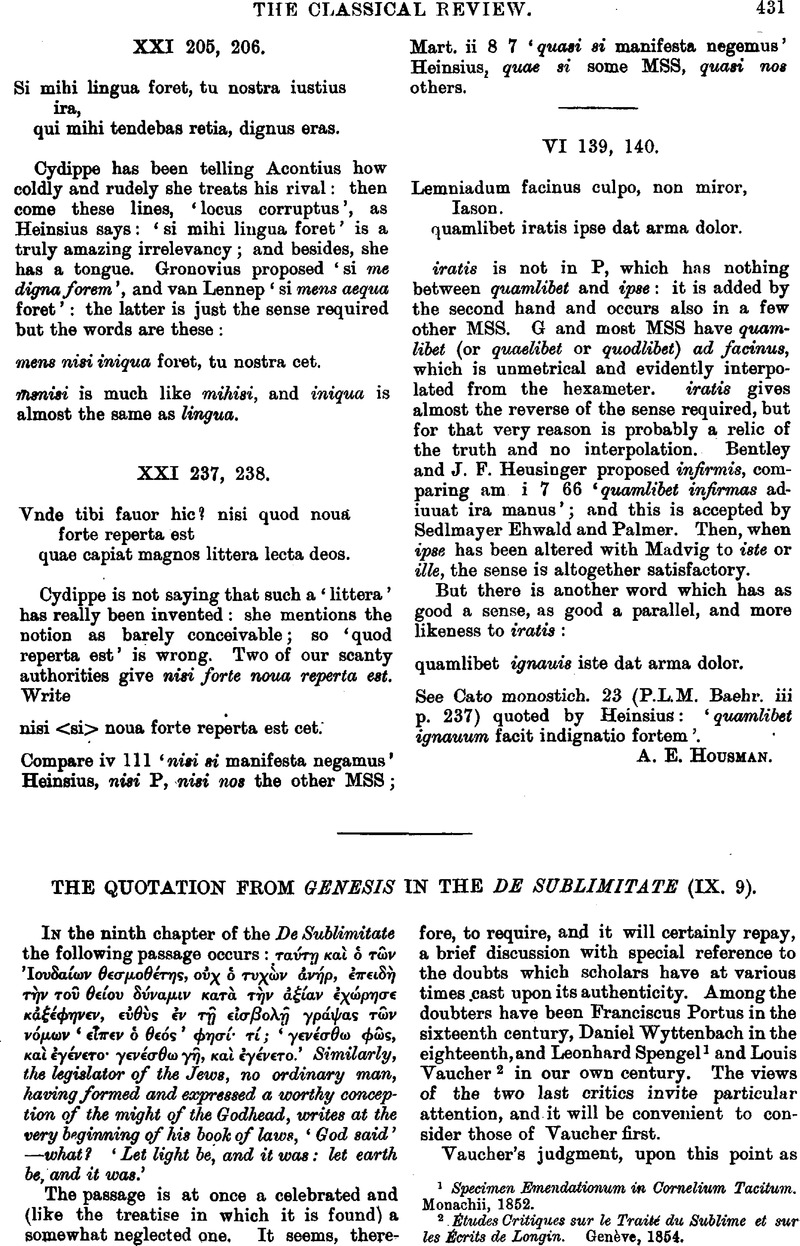No CrossRef data available.
Article contents
The Quotation from Genesis in the De sublimitate (IX. 9)
Published online by Cambridge University Press: 27 October 2009
Abstract

- Type
- Review Article
- Information
- Copyright
- Copyright © The Classical Association 1897
References
page 431 note 1 Specimen Emendationum in Cornelium Taciturn. Monachii, 1852.
page 431 note 2 Etudes Critiques sur le Traite du Sublime et sur les Ecrits de Longin. Genéve, 1864.
page 432 note 1 I should perhaps mention here that I hare recently had an opportunity of examining P 2036-for myself in the Bibliothéque Nationale.
page 432 note 2 Wolf, F. A., Vorlesungen über die Alterthumswis senschaft, i. 330: ‘Diese Stelle fallt wie vom Himmel hinein.’Google Scholar
page 433 note 1 ix. 10: ![]()
page 433 note 2 The contextual evidence, for and against the passage, is succinctly set forth by Canna, Giovanni, Della Sublimita: Libro attrihutio a Cassio Longino. Firenze, 1871. Pp. 18, 19.Google Scholar
page 433 note 3 Or should we see a reflection of i 3, 6, rather than of i. 3. 9, 10 ?
page 433 note 4 Cp. Hersel, H., Qua in citandis scriptorum et poetaruin locis auctor libelli περ ὔψ∘υς usus sit ratione. Berlin, 1884.Google Scholar
page 433 note 5 Freytag, J., De anonymi περ ὔψ∘υς sublimi genert dicendi. Hildesheim, 1897. P. 77.Google Scholar
page 434 note 1 The reference of course is to the fragment (if it to be regarded as genuine) given, e.g., by Vaucher, Etudes, p. 309.
page 434 note 2 Schurzfleischius, Animadversiones ad Dionysii Longini περ ὔψ∘υς commentationem. Vitembergae, 1711. P. 23.
page 434 note 3 For Caecilius reference may be made to Reinach, Théodore, Quid Judaeo cum Verre (in Revue des Études Juives, xxvi., 36–46Google Scholar) and to Caccialanza, F., Cecilio da, Calotte e l' Ellenismo a Roma nel secolo d' Auguato (in Rivista di Filologia e d' Istruzione Classica, xviii. 1–73Google Scholar). An article, by the present writer, on Caecilius of Calacte: a contribution to history of Greek Literary Criticism, will be found the current number (71) of the American Journal of Philology.
page 434 note 4 This point was emphasized (Philologus I. pp. 630, 631: year 1846) by G. Roeper, who also identified, from the Venice Scholia to the Iliad, the Ammonius mentioned in c. xiii.
page 435 note 1 Cp. Reinach, Th., Texles d'auteurs Grecs et Romains relatifs au Judaisme, pp. 14 ff.Google Scholar; Pape-Benseler, , Griechische Eigennamen, p. 969Google Scholar; Freudenthal, J., Hellenistische Studien, ii., pp. 177 ff.Google Scholar
page 435 note 2 Ryle, l.c., pp. xix., xx.—Reference should also be made to passages quoted by Reinach, Th., Textes d'auteurs, etc., pp. 18, 82, 361Google Scholar. The first passage is of special interest, particularly if the very early date claimed for it is correct. In it the end of ‘the laws’ seems to mean the end of Leviticus: ![]()
page 435 note 3 ![]() . xliv. 1.—πρς μ ἔναγχ∘ς is Cobet's reading, in place of πρ∘σναγχ∘σ as given by P. But there is reason to doubt whether a change is necessary, and with a view to the possible solution of the vexed question of the authorship it is better not to allow even slight deviations from P to pass unnoticed.
. xliv. 1.—πρς μ ἔναγχ∘ς is Cobet's reading, in place of πρ∘σναγχ∘σ as given by P. But there is reason to doubt whether a change is necessary, and with a view to the possible solution of the vexed question of the authorship it is better not to allow even slight deviations from P to pass unnoticed.
page 435 note 4 Cp. Bernays, Jacob (after Ruhnken) in Gesammelte Abhandlungen, I., pp. 347–356Google Scholar; von Arnim, Hans, Quellenstudien zu Philo von Alexandria, pp. 66 and 120Google Scholar.—One cannot help suggesting that Philo himself may conceivably have been the φιλσοφος into whose mouth the words in the De Sublimitate are put.
page 436 note 1 Sueton., Tib., 57; Quintil., Instit. Orat., iii. 1, 17.
page 436 note 2 xii. 4: ![]()
page 436 note 3 Th. Bergk, Griechische Litteraturgesehichte, iv., 553 n. 52.
page 436 note 4 J. Bernays, Ges. Abh., I. 353,4.
page 436 note 5 The critical editions of Iahn-Vahlen (Bonn, 1887) and of Spengel-Hammer, Rhetores Graeci, I. 2, Leipzig, 1894. In the latter. Hammer has deliberately removed the brackets in which Spengel, the original editor (1853), enclosed the passage.Google Scholar


